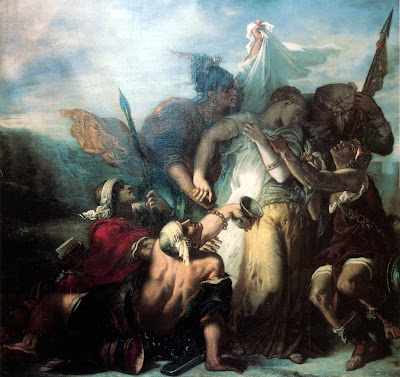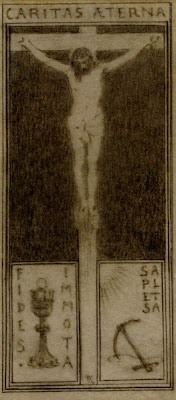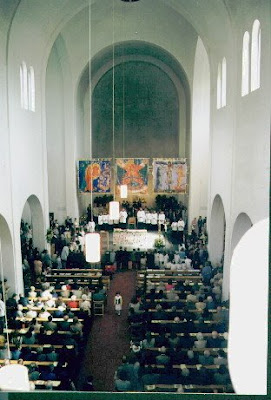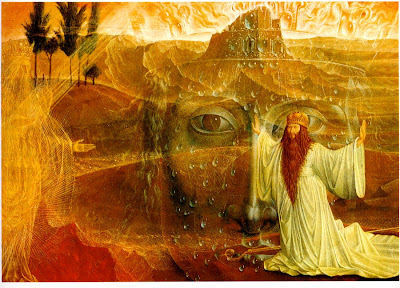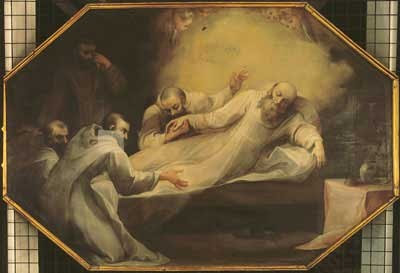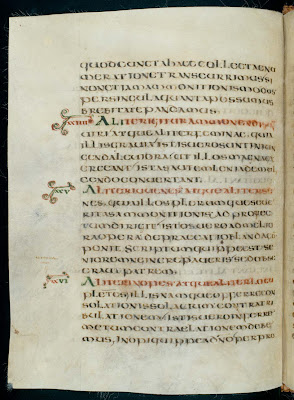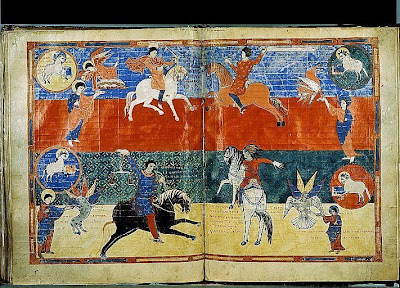.+(B.+N.,+MS.+Latin+8878)+++folio+109.jpg) The Second Seal
The Second Seal
Beatus Liebanensis, Commentarius in Apocalypsin (The Commentary on the Apocalypse of Beatus, abbot of Liebana.)(Saint-Sever)
Beatus de Saint-Sever (11th Century, before 1072)
MS Latin 8878, Folio 109
Bibliothèque nationale de France, Département des Manuscrits, Division occidentale, Paris
Rubric:
incipit explanatio libri quarti de equo albo. aperto primo sigillo cum dicat se vidisse equum album et aequitem et coronam et habentem in manu arcum
Legend :
nt ap quatrième sceau
Inscriptions :
agnus hic aperit quartum sigillum / johannes / tercium animal / unum de animalibus dicit johanni veni et vide / mors / equus pallidus et qui...
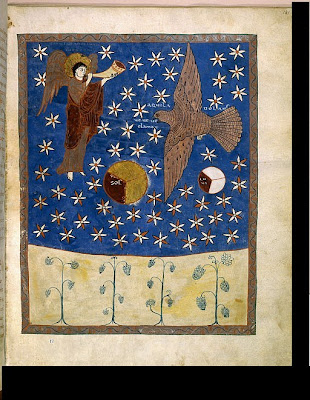 The Fourth Trumpet
The Fourth Trumpet
Beatus Liebanensis, Commentarius in Apocalypsin (The Commentary on the Apocalypse of Beatus, abbot of Liebana.)(Saint-Sever)
Beatus de Saint-Sever (11th Century, before 1072)
MS Latin 8878, Folio 141
Bibliothèque nationale de France, Département des Manuscrits, Division occidentale, Paris
Rubric :
incipit explanatio suprascriptae storiae. et quartus angelus tuba cecinit et percussa est tertia pars solis et tertia pars stellarum ezt tertia mars lunae ut obscuraretur tercia pars eorum et diei pareret et noctis
Legend :
nt ap quatrième trompette
Inscriptions :
quartus angelus tuba canit / sol / luna
 Satan and the dragon conquered
Satan and the dragon conquered
Beatus Liebanensis, Commentarius in Apocalypsin (The Commentary on the Apocalypse of Beatus, abbot of Liebana.)(Saint-Sever)
Beatus de Saint-Sever (11th Century, before 1072)
MS Latin 8878, Folio 202v
Bibliothèque nationale de France, Département des Manuscrits, Division occidentale, Paris
Rubrique :
incipit explanatio suprascriptae storiae. et vidi alium angelum descendentem de caelo
Legend :
nt ap satan & dragon immobilisés
Inscriptions :
ubi angelus ligavit draconem id est diabolum in abissum
Émile Mâle discussed the representation of the Book of Apocalypse in Medieval times. There were two schools: the Spanish; and the Anglo-Norman. The Anglo- Norman prevailed. Here Mâle discusses the Spanish school of depicting the Apocalypse, which was essentially a reflection of the Spanish society at the time. As most Apocalyptic visions are, the Spanish school reflected the crisis in Christian Spain.
"With childlike simplicity, the early miniaturists of the west tried to give a literal interpretation to passages from the Apocalypse. Of the two schools which seem to have worked at this subject the first is the Spanish school, which from the ninth to the twelfth century illuminated with crude colours the rude drawings accompanying the Commentary on the Apocalypse of Beatus, abbot of Liebana. M. Leopold Delisle has indicated the principal manuscripts of this group (manuscripts from Silos, Girone, Urgel, La Cogalla, &c.), of which the most beautiful the Apocalypse of Saint-Sever, is in the Bibliotheque Nationale.
All these manuscripts appear to derive from one original of the eighth or ninth century. The Spanish monks of Catalonia, Aragon or Navarre may have had the honour of being pioneers in the west of the illustration of the text of the Apocalypse. There was perhaps a certain harmony between the sombre poem and the Spanish temperament.
Their work though often rough is never crude. The figures in the Apocalypse of Saint-Sever stand out against a background of red or yellow like a fiery sunset, or sometimes against a band of quiet purple like a beautiful sky at night. Here and there are pages of considerable power, as for example the illustration of the eagle which flies in the midst of the stars crying, " Woe, woe, misery, misery," or the huge serpent covered with scales which is cast by an angel into the abyss.
By sheer force of simplicity the artist reached the sublimity of his text : " And I saw when the Lamb," says St. John, "opened one of the seals, and I heard as it were the noise of thunder, one of the four beasts saying, ' Come and see/ I saw and beheld a horse." The Spanish monk represents the winged lion flying towards St. John, taking his hand in his paw in a friendly way, and showing him a rider on a black horse.
Another school also attempted to illustrate the Apocalypse. Though its origin is somewhat obscure it certainly had its rise in England, for in a typical work of the school the manuscript is written in a French in which various Anglo-Norman idioms are used. We are far from the many coloured Apocalypses of Spain, for these miniatures are the work of artists with no real sense of colour. The backgrounds are white, and the drawing is merely covered with a slight wash. But each passage is literally rendered ; never were miniaturists more accurate or more loyal to their text. It is true that mystery vanishes, that the illimitable takes on a definite contour, and that the gigantic shrinks to human proportions, for their work though so estimable in other respects, is lacking in any element of the arresting, the rugged, the unexpected....
The [Anglo-Norman school] artist who first conceived these vigorous scenes [of the Apocalypse] , and drew them with a nervous pencil, worked for the future, for almost all works of art of the thirteenth and fourteenth centuries devoted to the Apocalypse, whether miniatures, glass, or bas-reliefs, are indebted to him in greater or less degree.
No such far-reaching influence was exerted by the Spanish school, for the illustrated Apocalypses of northern Spain hardly went beyond the Pyrenees, and never imposed their sway on the artists' imagination. The Anglo-Norman Apocalypse on the contrary, after inspiring the painters and sculptors of the Middle Ages, was a source of inspiration to the wood-engravers of the fifteenth century....
The vitality of the work of the Anglo-Norman miniaturists is remarkable. If it were within our province, we should like to point out how the old forms were perpetuated in art until the end of the fifteenth century, and how inspiration was sought in the originals up to the time when Albrecht Dürer created a new apocalyptic type."
Émile Mâle , The Gothic Image: Religious Art of the Thirteenth Century in France - A Study in Mediaeval Iconography and its Sources of Inspiration (3rd edition, publ. 1913) (translated by Dora Nussey) (1958), pages 358-360 and 363
The Commentary on the Apocalypse (Commentaria In Apocalypsin) was originally an eighth century work by the Asturian monk and theologian Beatus of Liébana. Saint Beatus of Liébana (c. 730 - c. 800) was a monk, theologian and geographer from the Kingdom of Asturias, in northern Spain, who worked and lived in the Picos de Europa mountains of the region of Liébana, in what is now Cantabria.
Twenty six illuminated copies of the Commentary have survived. Well-known copies include the Morgan, the Saint-Sever, the Osma and the Madrid (Vitr 14-1) Beatus.
The Beatus have been the subject of extensive scholarly and antiquarian enquiry.
After 711 A.D., Spanish Christians found themselves being persecuted by Muslims. They could no longer practice their religion openly. Bells and processions were forbidden. Churches and monasteries were destroyed and were unable to be reconstructed. Persecutions often led to bloody outcomes.
The Apocalypse became a support for the Christian resistance. The symbolism in it took on a whole new meaning for them. The Beast, which had previously been believed to represent the Roman empire, now became the Califate, and Babylon was no longer Rome, but Córdoba.
The Apocalypse, which before had been interpreted as a prophecy of the end of Roman persecution, became the cry for Reconquista and a promise of deliverance and punishment.
The manuscript Beatus de Saint-Sever in the Bibliothèque nationale de France was made during the time that Grégoire de Montaner was Abbot of Saint-Sever (from 1028 to 1072). One of the scribes (and perhaps one of the painters) was Stephanius Garsia. It is likely,however, that there were several scribes and painters.
The pages measure 365 x 280 mm. The style is French Roman but some experts have seen influence also from Ireland.
 Clarence Gagnon 1881-1942
Clarence Gagnon 1881-1942













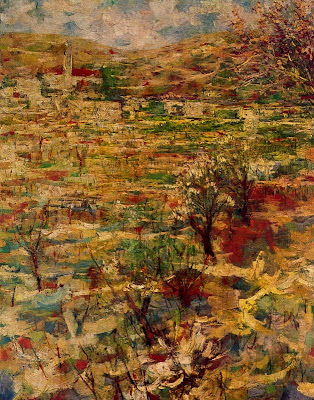
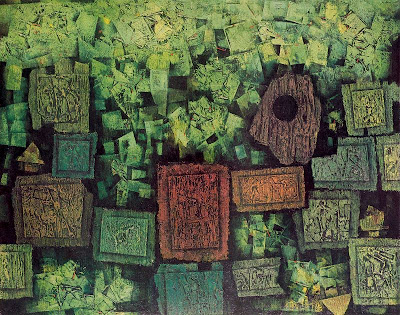



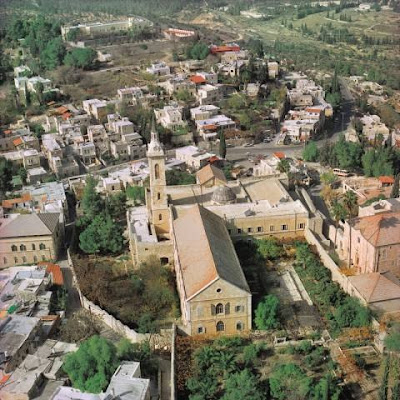





.+(B.+N.,+MS.+Latin+8878)+++folio+109.jpg)


